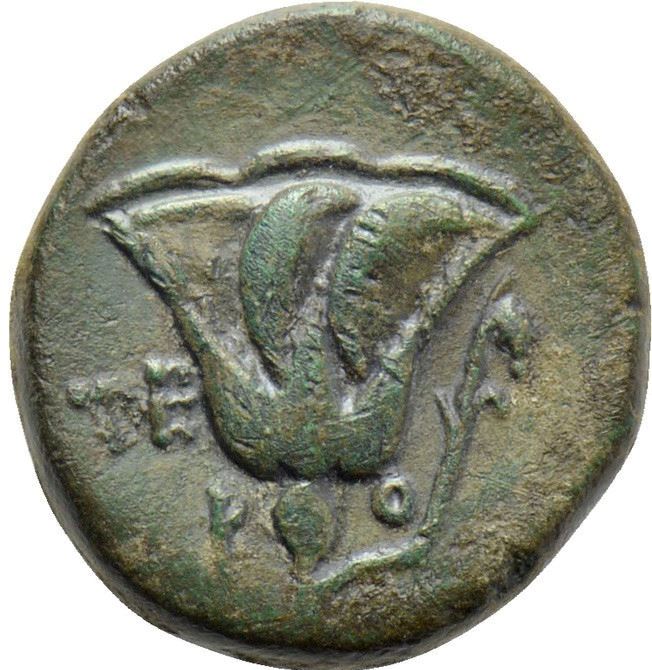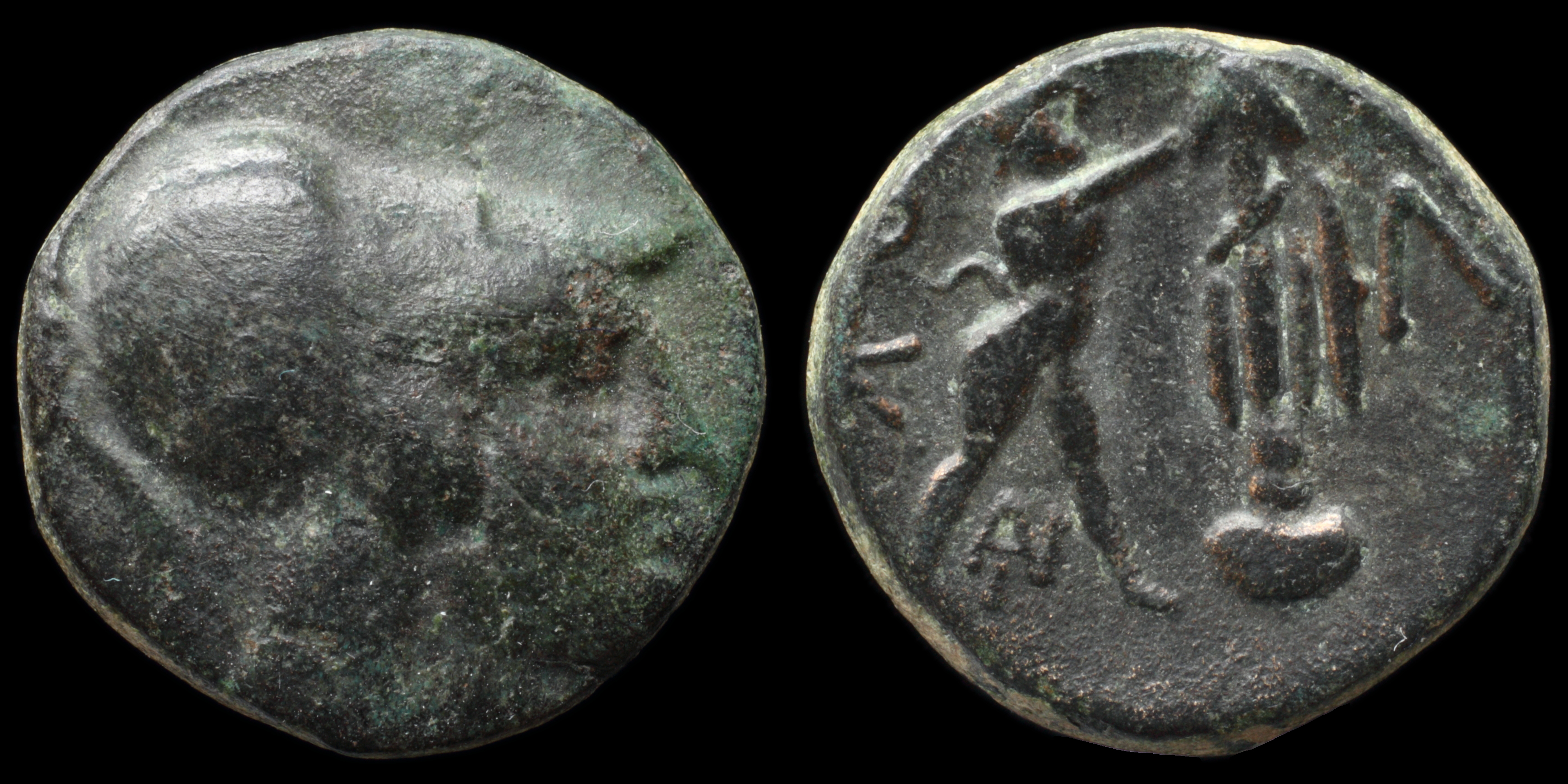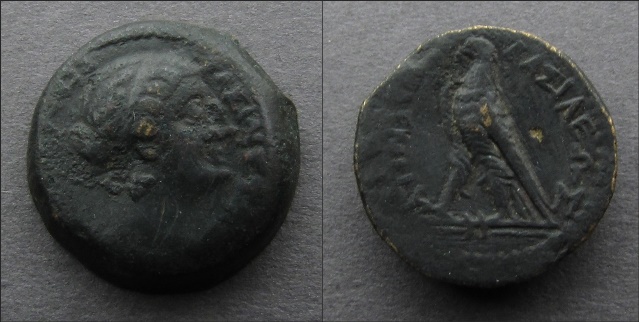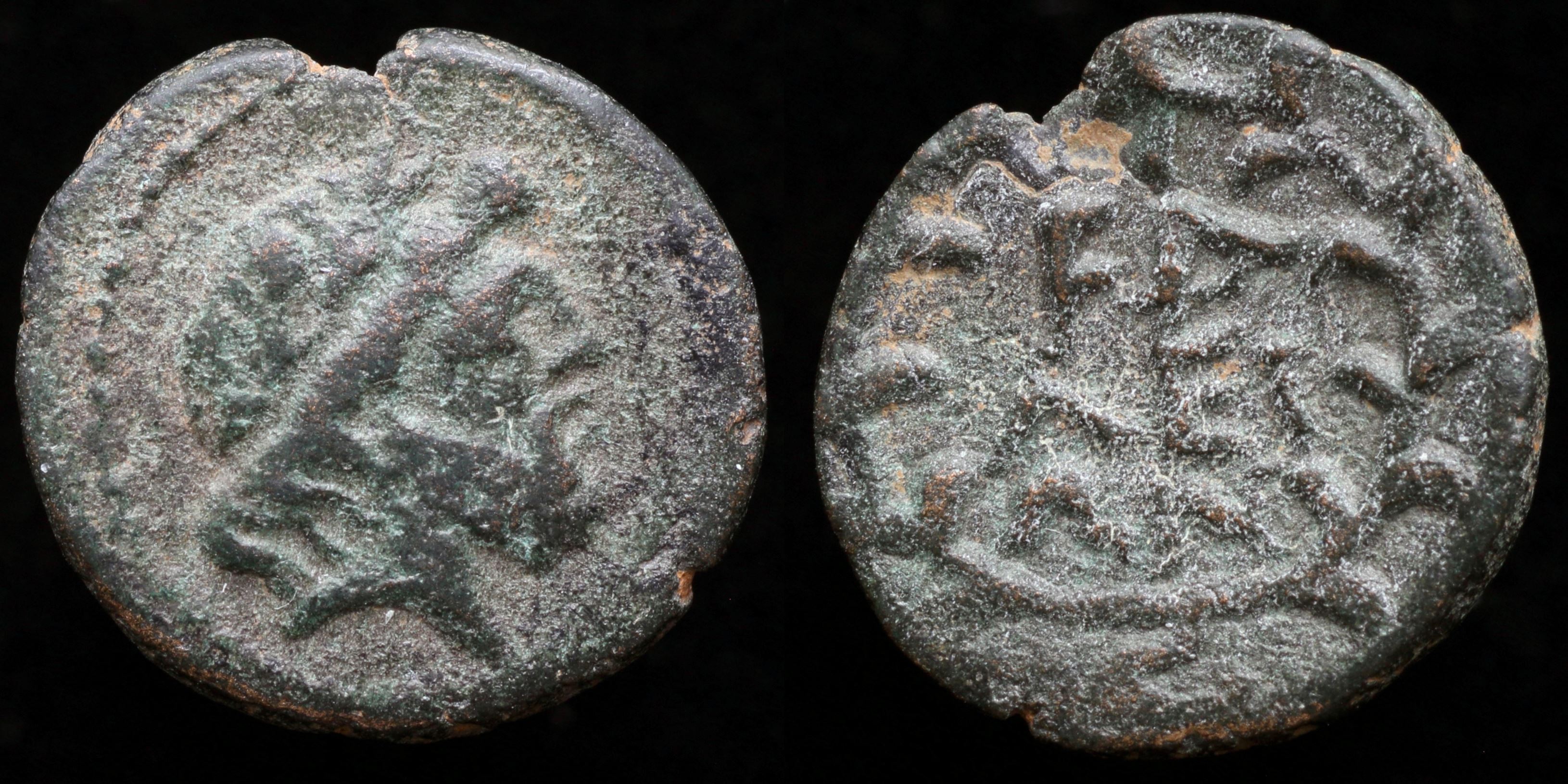The tetrachalkon is an ancient Greek bronze denomination worth 4 chalkoi.
It is roughly equivalent to one hemiobol - or 1/12th of a drachm.
It is roughly equivalent to one hemiobol - or 1/12th of a drachm.

(1)
Antigones II

An
AE
Tetrachalkon
struck 277-239 BC
in
Macedonia
Obverse: head of Athena wearing crested Corinthin helmet right
Reverse: Pan standing right, erecting trophy; B / K / Φ _ Λ // (ANT)
Diameter:
15 mm
Die Orientation: -
Weight: 4.1 g
Die Orientation: -
Weight: 4.1 g
No notes for this coin
AMNG 187, 6 Tf. 34,4, SNG Cop. 1209.
(2)
Apameia
.jpg)
An
AE
Tetrachalkon
struck 133-48 BC
in
Apameia
Obverse: laureate head of Zeus right
Reverse: Artemis Anatis facing AΠAME / HPAKΛEI / EΓΛO
Diameter:
19.5 mm
Die Orientation: -
Weight: 7.52 g
Die Orientation: -
Weight: 7.52 g
No notes for this coin
BMC Phrygia 69; SNG Cop 183; SGCV II 5121; SNG von Aulock 347
(3)
Berenike II

An
AE
Tetrachalkon
struck 46-221 BC
in
Akko-Ptolemais
Obverse: BEΡENIKHΣ BAΣIΛIΣΣHΣ or abbreviated, head of Berenike II right, hair in a bun.
Reverse: BAΣIΛEΩΣ ΠTOΛEMAIOY, eagle standing left on thunderbolt, wings closed.
Diameter:
20.87 mm
Die Orientation: 12 H
Weight: 8.78 g
Die Orientation: 12 H
Weight: 8.78 g
Berenike II was the daughter of Magas (king of Cyrene) and Arsinoe/Apama, born in c. 267/6. Berenike II first married or was engaged to Demetrius the Fair (son of Demetrius Poliorcetes and Ptolemais) in c249, as his second marriage, which terminated shortly thereafter by his murder when he was caught in flagrante delictu with her mother Arsinoe/Apama. By him she had no children. Berenike II second marriage was with Ptolemy III (king of Egypt), probably in early 246, by whom she had Ptolemy IV, Magas, Arsinoe III and Berenike, and is presumed to have had an unknown son. Berenike is said to have participated in the Nemean Games and won (between 245 and 241 BC) and to have competed in Olympic games at some unknown date. Soon after her second husband's death in 221 BC, she was murdered at the instigation of her son, Ptolemy IV, with whom she probably was associated in the government.
Svoronos 1055; BMC 17; Sear Greece 7821; Paris 351.
(4)
Olympia

An
AE
Tetrachalkon
struck c. 150 BC
in
Olympia
Obverse: laureate head of Zeus right
Reverse: legend within wreath; FA / ΛEI / ΩN
Diameter:
18 mm
Die Orientation: -
Weight: 3.9 g
Die Orientation: -
Weight: 3.9 g
No notes for this coin
Cf. BCD Olympia 302-5; cf. SNG Copenhagen 446-8; cf. BMC 150
(5)
Pantikapaion
.jpg)
An
AE
Tetrachalkon
struck 310-304/3 BC
in
Pantikapaion
Obverse: Bearded head of satyr Pan right
Reverse: Forepart of griffin left; below, sturgeon left.
Diameter:
21 mm
Die Orientation: -
Weight: 6.98 g
Die Orientation: -
Weight: 6.98 g
No notes for this coin
Sear 1700; MacDonald 69; Anokhin 111; SNG BM Black Sea 869-871.
(6)
Rhodos

An
AE
Tetrachalkon
struck 229-205 BC
in
Rhodos
Obverse: Laureate head of Zeus right
Reverse: P - O, Rose with bud to right. Control: TE to left
Diameter:
18 mm
Die Orientation: -
Weight: 5.73 g
Die Orientation: -
Weight: 5.73 g
Ashton links this and several related coinage issues to the period immediately after the great earthquake that struck Rhodes circa 229-226 BC.
The city and port were devastated, and the great bronze Colossus beside the harbor was demolished. Greek states all over the eastern Mediterranean shipped in relief supplies, with Ptolemy III of Egypt being particularly generous. The Zeus head may reflect an Egyptian connection - the Rhodians honoring their benefactors.
The city and port were devastated, and the great bronze Colossus beside the harbor was demolished. Greek states all over the eastern Mediterranean shipped in relief supplies, with Ptolemy III of Egypt being particularly generous. The Zeus head may reflect an Egyptian connection - the Rhodians honoring their benefactors.
Ashton 234; HGC 6, 1469.
